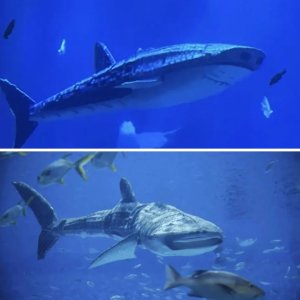Shocking Discovery: Aquarium Visitors Learn the Truth About Their Beloved Whale Shark!
By
Aubrey Razon
- Replies 0
At the Xiaomeisha Sea World in China, visitors flock to witness the grandeur of marine life, expecting to be awed by the majestic whale shark, the ocean's gentle giant. The whale shark exhibit, a star attraction, promises an up-close encounter with one of nature's most fascinating creatures.
But for some guests, the experience took an unexpected turn, leading to a wave of controversy that rippled far beyond the aquarium's walls.
The robotic whale shark, while an impressive feat of engineering, sported visible seams that betrayed its artificial nature, reminiscent of a prop from a low-budget science fiction film.
The aquarium's decision to showcase a robotic whale shark was not an attempt to deceive, but a compliance with international regulations that prohibit the trade and captivity of real whale sharks.
Despite the good intentions behind the mechanical marvel, which cost millions of yuan to create, the revelation left many visitors feeling duped and disappointed.
Complaints ranged from the aquarium's size and facilities to the letdown of the whale shark exhibit itself.
Some visitors, expecting a living, breathing specimen, felt the robotic replacement fell flat, lacking the awe-inspiring presence of an actual whale shark.
“Even though it’s for the sake of animal protection, I’d rather they didn’t have one at all than show a fake one,” complained one.
The aquarium representatives responded to the criticism, emphasizing their commitment to animal protection and the legal constraints they faced.
However, this did little to quell the dissatisfaction among guests, some of whom argued they would have preferred no exhibit over a faux one.
One observant visitor noted signs of white spot disease among the fish, a common ailment in tropical aquariums that can indicate subpar living conditions. This raised questions about the overall welfare of the creatures under Xiaomeisha's care.
“Most people wouldn’t notice, but anyone who’s kept tropical fish knows that’s white spot disease,” explained one visitor. “Some of the fish didn’t appear to be in good health.”
This incident is not an isolated one.
There have been previous instances where Chinese zoos and aquariums have come under fire for presenting less-than-authentic wildlife experiences.
From dyed dogs masquerading as exotic big cats to other mechanical animal replacements, these episodes have sparked debates about ethical standards and visitor expectations in wildlife exhibits.
As we navigate these waters, it's crucial for facilities like Xiaomeisha to be transparent with their visitors about what they're seeing and why. Education about conservation can and should include discussions about the challenges of protecting endangered species like the whale shark, and the reasons why a robotic substitute might be used.
 Have you visited an aquarium or zoo and encountered something unexpected that changed your perspective? How do you feel about the use of robotic animals in educational settings? Share your thoughts and experiences in the comments below.
Have you visited an aquarium or zoo and encountered something unexpected that changed your perspective? How do you feel about the use of robotic animals in educational settings? Share your thoughts and experiences in the comments below.
But for some guests, the experience took an unexpected turn, leading to a wave of controversy that rippled far beyond the aquarium's walls.
The Unexpected Twist: A Mechanical Marvel?
Imagine the surprise and subsequent dismay when visitors peering through the glass discovered that the creature they came to see was not flesh, blood, and cartilage, but rather a sophisticated assembly of metal and machinery.The robotic whale shark, while an impressive feat of engineering, sported visible seams that betrayed its artificial nature, reminiscent of a prop from a low-budget science fiction film.
The aquarium's decision to showcase a robotic whale shark was not an attempt to deceive, but a compliance with international regulations that prohibit the trade and captivity of real whale sharks.
Despite the good intentions behind the mechanical marvel, which cost millions of yuan to create, the revelation left many visitors feeling duped and disappointed.
The Criticism Swirls Like a Sharknado
The backlash was swift and fierce, with patrons taking to social media to express their discontent.Complaints ranged from the aquarium's size and facilities to the letdown of the whale shark exhibit itself.
Some visitors, expecting a living, breathing specimen, felt the robotic replacement fell flat, lacking the awe-inspiring presence of an actual whale shark.
“Even though it’s for the sake of animal protection, I’d rather they didn’t have one at all than show a fake one,” complained one.
The aquarium representatives responded to the criticism, emphasizing their commitment to animal protection and the legal constraints they faced.
However, this did little to quell the dissatisfaction among guests, some of whom argued they would have preferred no exhibit over a faux one.
Beyond the Robo-Shark: Concerns Over Live Exhibits
The controversy didn't stop at the robotic whale shark. Scrutiny extended to the care of the aquarium's live inhabitants.One observant visitor noted signs of white spot disease among the fish, a common ailment in tropical aquariums that can indicate subpar living conditions. This raised questions about the overall welfare of the creatures under Xiaomeisha's care.
“Most people wouldn’t notice, but anyone who’s kept tropical fish knows that’s white spot disease,” explained one visitor. “Some of the fish didn’t appear to be in good health.”
This incident is not an isolated one.
There have been previous instances where Chinese zoos and aquariums have come under fire for presenting less-than-authentic wildlife experiences.
From dyed dogs masquerading as exotic big cats to other mechanical animal replacements, these episodes have sparked debates about ethical standards and visitor expectations in wildlife exhibits.
As we navigate these waters, it's crucial for facilities like Xiaomeisha to be transparent with their visitors about what they're seeing and why. Education about conservation can and should include discussions about the challenges of protecting endangered species like the whale shark, and the reasons why a robotic substitute might be used.
Key Takeaways
- Visitors at Xiaomeisha Sea World were shocked to discover that their star whale shark exhibit was actually a robotic replica.
- Customers voiced their dissatisfaction online, with some feeling cheated and demanding refunds.
- Representatives from Xiaomeisha stated that the mechanical whale shark was created in compliance with laws prohibiting the trade of real whale sharks.
- There was additional criticism raised about the care of live fish at the park, with allegations of poor health and signs of white spot disease.







